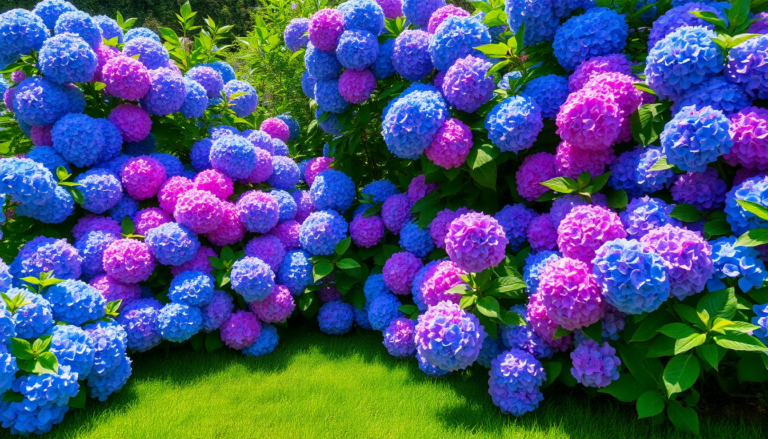Argomenti trattati
Imagine stepping into your garden and being welcomed by an explosion of colors—lush blooms of hydrangeas in shades of blue, purple, and pink, all vying for your attention. That’s the magic of these delightful plants. Not only do hydrangeas add vibrant charm to any landscape, but they also possess a unique ability to change their colors based on the soil they grow in. Yes, you heard that right! By managing soil acidity, you can coax these beauties into a kaleidoscopic display that’ll have your neighbors green with envy.
Understanding the different types of hydrangeas
When it comes to hydrangeas, there are around six main types that thrive across the United States, each with its own unique characteristics. Among them, bigleaf hydrangeas (Hydrangea macrophylla) are the most popular. Their blooms can be either the classic pom-pom style or elegant clusters, making them a favorite for many gardeners. If you’re looking to introduce a splash of color variety to your yard, bigleaf hydrangeas are the way to go.
Next up are smooth hydrangeas (Hydrangea arborescens), known for their slender leaves and long stems, while panicle hydrangeas (Hydrangea paniculata) stand out with their conical flower shapes. Generally, hydrangeas prefer USDA Hardiness Zones 5 to 9, though different varieties may have slight variations in hardiness. I remember when I first planted my bigleaf hydrangeas; I was so mesmerized by their transformation over the seasons that I couldn’t help but check on them daily!
Best practices for planting hydrangeas
The ideal time to plant hydrangeas is during fall or early spring. This timing gives their roots a chance to establish themselves robustly before facing harsh conditions, like those blazing summer days. According to gardening expert Mallory Micetich, hydrangeas thrive beautifully in garden beds, large pots, or as part of shrub borders. They’re incredibly versatile!
Hydrangeas can flourish in shaded areas of your yard, where many other plants might struggle. As Teri Valenzuela from Sunday Lawn Care points out, this makes them a perfect choice for spots that receive less sunlight while still wanting to add color and life to your garden. However, keep in mind that while they can tolerate some shade, most hydrangeas need about four to six hours of sunlight daily to bloom their best. Just avoid planting them under trees where their roots will compete for water and nutrients—trust me, that’s a recipe for disappointment!
Watering and soil care for hydrangeas
One crucial aspect of hydrangea care is ensuring they have well-drained soil. Bryan Clayton, CEO of GreenPal, emphasizes that hydrangeas don’t like standing water. They need consistent moisture but be careful—overwatering can lead to yellowing leaves, which is never a good sign. I’ve learned this the hard way, and now I keep a close eye on the moisture levels, especially during dryer spells.
When planting hydrangeas, aim to give them some space. Planting them at least three feet apart allows for good airflow and healthy growth. Regular watering, particularly through dry spells, is essential. Hydrangeas are thirsty plants, and they’ll reward you with stunning blooms if you keep them hydrated.
Playing with color: The art of soil pH adjustment
What’s truly fascinating about hydrangeas is their ability to change color based on the soil’s pH level. This means that with a little experimentation, you can create a unique display of colors right in your garden. Not all varieties will shift colors, though, so if you’re looking to play this game, go for the bigleaf hydrangeas with mophead or lacecap heads.
To start, test your soil’s pH level using an at-home kit (you can find one for about $13). Once you know where you stand, you can adjust the soil’s acidity to get the color you want. Generally, more acidic soil will give you blue tones, while alkaline conditions will yield pink. Micetich suggests using soil acidifiers, coffee grounds, or even citrus peels to lower pH, while crushed eggshells or ground lime can help make it more alkaline. Just be patient—sometimes it takes a few months for the hydrangeas to adjust, but the wait is so worth it!
Caring for hydrangeas: Pruning and more
Another tip for keeping your hydrangeas happy is to occasionally cut fresh flowers for indoor arrangements. Valenzuela notes that this not only brings a cheerful touch to your home but also encourages more flowering outdoors. It’s like a little gift that keeps on giving! I can’t tell you how many times I’ve brought a bouquet of hydrangeas into my living room, and the vibrant colors instantly lifted my spirits.
And here’s a lesser-known gem: Ben Hilton, a gardening expert, swears by using Epsom salt (magnesium sulfate) around hydrangeas. It’s said to improve flower colors, promote robust blooms, and even reduce the risk of fungal infections. Who knew a mineral could work such wonders?
In the end, hydrangeas are not just flowers; they’re a delightful experiment waiting to happen in your garden. With a little care, proper planting, and a dash of creativity with soil management, you can create a breathtaking display that reflects your personality and style. So go ahead, dive into the world of hydrangeas, and let your garden bloom with magic!

